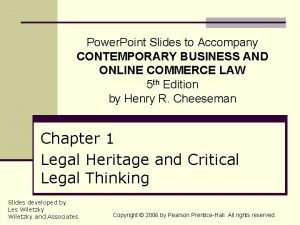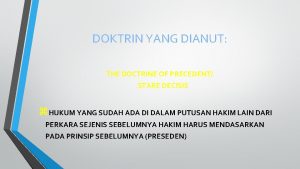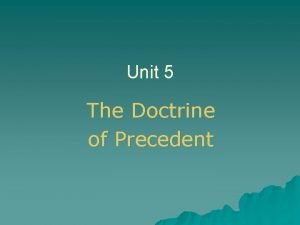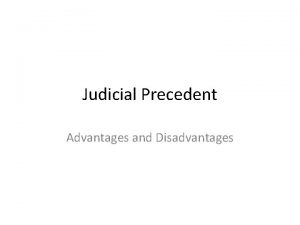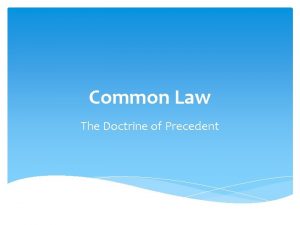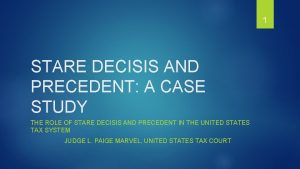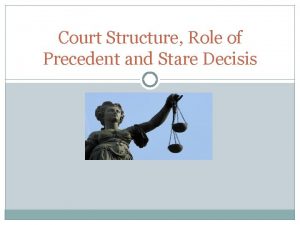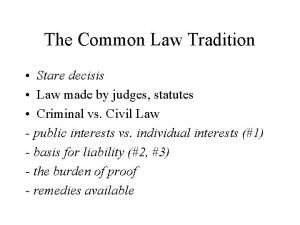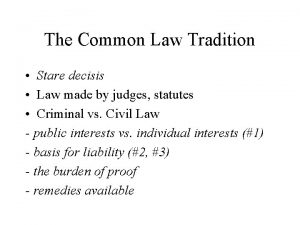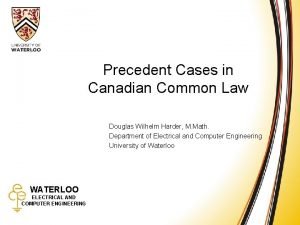Precedent stare decisis v change of case law








- Slides: 8

Precedent: stare decisis v. change of case law Sweden Justice Kristina Ståhl Supreme Administrative Court 1

The Swedish court system • General courts that deal with criminal law and private law. • Administrative courts that deal with administrative law, including tax law. • The Supreme Court and the Supreme Administrative Court have as their main task to deliver precedents. • Approximately 8000 cases (of which 1/3 are tax cases) are appealed to the Supreme Administrative Court every year. • Leave to appeal is granted in less than two percent of the cases. 2 HÖGSTA FÖRVALTNINGSDOMSTOLEN

The Swedish court system • There are 16 judges in the Supreme Administrative Court. • When delivering a judgment, the court consists of five judges. • If the judges agree on the outcome and the reasoning of the case, they deliver a joint (collective) judgment. • If someone disagrees with the outcome or the reasoning, he or she may express a dissenting opinion. • It is also possible for a judge that agrees with the majority to further develop his or hers reasoning in a separate opinion. 3 HÖGSTA FÖRVALTNINGSDOMSTOLEN

The rule of law rules in tax law • Sweden adheres to the principle ”no tax without law” (”nullum tributum sine lege”). • It is stated in the Constitution that tax shall follow from law enacted by Parliament. • The competence to issue tax provisions can not be delegated to the Government or to a public authority. • In principle, the courts may not overstep the boundaries of written tax law. 4 HÖGSTA FÖRVALTNINGSDOMSTOLEN

Statute law v. precedents • Statute law is the primary source of law. • Case law from the Supreme Administrative Court is not formally binding. • However, in practice it is followed by lower courts and by the Supreme Administrative Court itself as if it was binding. • This is true not only when a judgment is well reasoned and thus has persuasive authority. • Also ill-founded judgments are accepted as precedents and followed by lower courts. • If the Supreme Administrative Court wants to change its case law, it feels obliged to do so through a plenary decision. 5

The writing of a precedent • The judgments are quite long. • They often consist of a general part where the Court undertakes a broader analysis of the current issue. • After that, the Court applies this analysis to the circumstances of the present case. • The judgments regularly include references to previous case law. 6

Some merits of the Swedish system… • The honoring of the rule of law gives the system democratic legitimacy and promotes legal certainty (the Court can only maneuver within the boundaries of written law). • Following previous case law promotes predictability. • Judgments that are thoroughly reasoned promote transparency. 7

… and some drawbacks • The ambition to write broad judgments that may work as precedents also in cases where the circumstances are different may turn the Court into a legislator. • Previous case law may work as a straitjacket, not allowing the Court to make the best decision in the case before it. • There may be a reluctance to refer a case to a plenary decision in order to change case law. In principle, this is done only in cases that raise questions of more fundamental importance. 8
